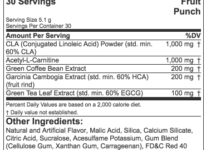If you learn how to calculate macros, you will have an easier time gaining muscle mass and losing body fat.
Once upon a time, people believed that they got fat or skinny because of a certain food they ate. They thought that pizza or a hamburger would make them fat because of some magical combination of nutrients. And guess what – many people still that’s true! There are all kinds of nutrition experts saying how they have a special meal recipe that burns fat and similar nonsense. That’s completely false. What scientific research and practical experiments conducted by everyday people have repeatedly shown is that whether you’re trying to gain, lose or maintain weight, the most important part of the equation are the macros.
Caloric Intake & Learning how to calculate macros
Macros is short for macronutrients, and there are three of them: protein, fats and carbohydrates. By calculating how much of them we need to eat on a daily basis, we can tweak our diet to either lose fat or gain muscle at will. Macros are also inherently combined with caloric intake, since each of the macros carries a certain amount of calories:
1 gram of protein – 4 calories
1 gram of carbs – 4 calories
1 gram of fats – 9 calories
What Are Calories?
Calories are essentially blocks of energy. We need calories to function properly, they act as fuel for our body. If we eat more calories than we need, they will be stored as fat reserves, and our bodyfat percentage will go up. If we eat just the right amount of calories that our body needs to sustain it’s current form, then we’ll remain the same. If we eat less calories than our body requires for maintenance, it will respond by using the fat reserves for additional energy. That’s the whole magic behind weight loss.
Why is Calculating Macros Important?
In order to manipulate our body weight, in theory we don’t need to pay attention to what we eat. The only important thing is the caloric intake. So you can eat pizza every day, and as long as you are eating below the maintenance level, you will lose weight. However, macros are important if you actually care about looking good and staying healthy. There is a certain amount of protein that you need in order to build a muscular physique. There is also a certain amount of fat and carbs that is considered to be optimal for most people. So the ratio of macros is important for health and aesthetic reasons.
For example, too much fat can cause clogging of the arteries, or digestive problems. Too much carbs, or processed foods will lead to high blood sugar and diabetes, while too little carbs will have a negative impact on training performance. The same logic applies to protein – too much protein can cause kidney problems, whereas not enough protein will cause muscle decomposition, as it’s the main building block of muscle tissue.
In order to learn how to calculate macros you need to know how much calories your body needs for maintenance. There are a few tools that can help you to find out your maintenance level, and count your macros as well, but it’s good to know more in detail as well, so keep reading. The tools can be found on the internet.
So let’s say that you weigh 195 pounds. After that you would need to estimate your bodyfat percentage. Generally, having barely visible ads puts you at around 15-17%. Really visible abs sets you at 10 or below 10%, depending on other visual aspects as well, such as vascularity and muscle tone. So let’s say that you established your bodyfat is about 15%.
The next thing you need to know is your TDEE (total daily energy expenditure). TDEE can vary largely from person to person. It depends on how much physical activity you do, and it’s not only based on training efforts. So let’s say you walk to work, or ride on your bicycle a lot. All of that extra activity adds up. However, when measuring TDEE, the basic way to do it is by calculating how many hours you exercise every week. If it’s over 6 hours a week, you definitely have a high TDEE. This means that you’re burning a lot of calories, and therefore your overall caloric intake should be reasonably high. Basically, by using the calculators linked above, what the program does is:
- Put together a formula combining your WEIGHT, BODYFAT and ACTIVITY LEVEL
- Measures your TDEE and LBM (lean body mass)
- Suggests the amount of calories you need to eat in order to maintain that weight
So now that you know your average TDEE, you know how much calories you need to consume daily to maintain your weight. If you want to lose weight in a healthy way and on a consistent basis, you would eat 10-20% less than your TDEE. If you want to maintain the weight, you would eat the same amount, and if you want to gain weight you would eat 10% more. Eating more than 10% would put you at a risk of gaining fat instead of muscle. Now that we know how caloric intake functions, let’s look at each macro separately and determine how to calculate their intake.
Protein
Although there is still a lot of debate about how much protein we actually need, the truth is that protein is the most important part of the calculating your macros. It’s the building block of muscle, and it’s more satiating than either carbs or fats.
The most important thing when measuring your protein intake is knowing your LBM (lean body mass). Because the general rule is to eat 1 gram of protein per lean body mass. So if you weigh 195 pounds, and your LBM is 165 pounds, you would need to consume 165 daily.
How much calories is in 165 grams of protein? Well, 1 gram of protein is 4 calories, so 165×4= 660 calories.
If your TDEE is 2500 calories, that leaves us with 2340 calories to fill up with carbs and fats.
Including Fats in calculating your macros.
Fats had a truly bad rep for most of the 20th century. They were considered as the ultimate evil that leads to heart disease and obesity. Newer research shows that these claims were highly exaggerated, with HFLC and Paleo diets proving to be very useful for weight loss. A moderate intake of fats is good for everyone, as fats are necessary for proper functioning of the endocrine system, especially healthy unsaturated fats found in vegetable oils, nuts, and fish. A moderate intake of fats is 0,3 grams per bodyweight. So our imagined friend of 195 pounds would have to consume 58.5 grams of fats. As we’ve established earlier, 1 gram of fat equals 9 calories. That means he would eat 526.5 calories from fats.
Carbs
Now that we know the protein and fat intake, we need to get our carb intake in check. Carbs are often touted as the main enemy of a lean physique. In fact, carbs are an excellent source of energy, and they are important for strength, endurance, and athletic performance in general. Glucose is the preferred energy source in the human body, and by eating carbs we have enough glucose reserves to get the necessary energy to hit the weights and do cardio at a higher intensity. Just like with protein and fats, if our caloric intake is under check, we can eat any, and as much as we want. Since this is the 3rd macro, calculating the intake is pretty easy. Since the TDEE was 2500 calories, that leaves us with 1300 calories. If 1 gram of carbs is 4 calories we need to divide 1300 with 4. We get 325 g of carbs.
So the macros are:
Protein – 165 g
Fats – 58.5
Carbs – 328 g
But Not So Fast
As I’ve mentioned before, it’s impossible to get your macros in order on the first try. The problem is that we have to take into consideration metabolism, some unexpected physical activity, stress factors and genetics. Calculating macros is a great way to start, but afterwards it is important to feel how the body responds, and see whether it is changing in the way you want. Perhaps you need to eat more or less, and you’ll find that out after a few days of implementing the new macronutrient and caloric intake.
Some people also find it to be too much work to calculate macros, check the food labels and weigh their food. However, this is in fact very simple, it just takes some time to get used to. There are also high quality applications that can help you, myfitnesspal being the most widely used.
Conclusion (How To Calculate Macros)
If you’ve always wondered how to lose weight or gain muscle without having to eat a strict, clean diet, and having to avoid your favorite foods, now you know how to avoid those boring and tedious aspects of dieting. Simply calculate your macros and calories, and eat any food you like as long as it fits your macros. I hope this article will help you in doing exactly that, and achieving physique altering results the fun way.
Alex Rogers is a supplement manufacturing expert. He has been formulating, consulting, & manufacturing dietary supplements since 1998. Alex invented protein customization in 1998 & was the first company to allow consumers to create their own protein blends. He helped create the first supplement to contain natural follistatin, invented whey protein with egg lecithin, & recently imported the world’s first 100% hydrolyzed whey.






